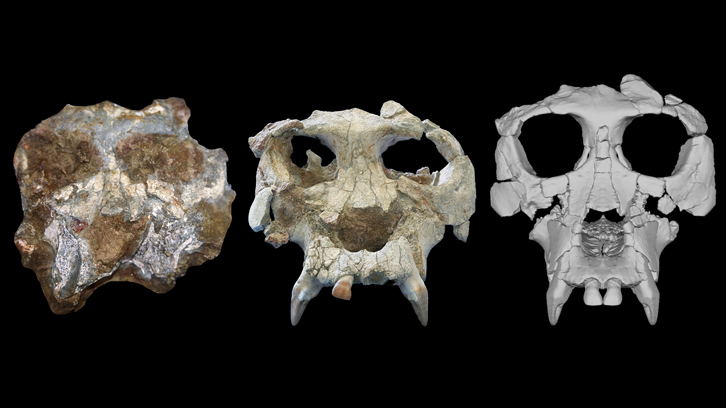12 million years later, Pierolapithecus gets a facelift

A research team from the Institut Català de Paleontologia Miquel Crusafont and the American Museum of Natural History has reconstructed the face of the Miocene great ape Pierolapithecus and, on its basis, investigates the evolutionary history of the hominoid face. The results are consistent with Pierolapithecus being a basal great ape close in facial morphology with the last common ancestor of great apes and humans.
More than twenty years ago, a partial skeleton of a fossil great ape was recovered during the construction of the Can Mata landfill in the Can Vila Ravine, in the municipality of els Hostalets de Pierola within the Vallès-Penedès Basin (NE Iberian Peninsula). The skeleton belongs to an adult male—nicknamed “Pau” by journalists—who inhabited the area about 12 million years ago during the Middle Miocene. In 2004, a new genus and species (Pierolapithecus catalaunicus) was erected, which belongs to a now-extinct group—informally termed ‘dryopiths’—that lived in Europe during the Miocene.
The skeleton of Pierolapithecus constitutes a rarity in the ape fossil record because it combines facial remains with other key parts of the skeleton, thus being of utmost importance for understanding the mosaic nature of great ape evolution and their evolutionary radiation in Europe during the Miocene. Nevertheless, since its original description in 2004, Pierolapithecus has been surrounded by controversy regarding its kinship relationships to—and distinctiveness from—other dryopith genera. Thus, Pierolapithecus and other dryopiths are generally considered to have originated before the split of the orangutan lineage from that of African apes (gorillas and chimpanzees) and humans, but some researchers still advocate a closer relationship with African great apes and humans. Similarly, given the presence of other, roughly coeval great ape genera (Dryopithecus and Anoiapithecus) in the same area, the distinctiveness of Pierolapithecus has been questioned, mostly on the basis that its facial morphology was distorted during the fossilization processes.
Until now, the extent to which damage might hinder an adequate assessment of the facial morphology of Pierolapithecus remained uncertain. In an effort to bring clarity to these questions, an international team led by the American Museum of Natural History and the Institut Català de Paleontologia Miquel Crusafont has published a digital reconstruction and 3D shape analyses of the Pierolapithecus face in the Proceedings of the National Academy of Sciences USA. In particular, Pugh and colleagues use computed tomography scans to virtually reconstruct the 3D structure of the craniofacial skeleton of Pierolapithecus and compare it to those of other primates using state-of-the-art phylogenetically-informed morphometric approaches. Their results enable a better understanding of the morphologic affinities of the Pierolapithecus facial features and reconstruct the evolutionary history of the hominid face more generally.
The results support the hypothesis that Pierolapithecus represents a basal hominid that differs in facial morphology from extant great apes (orangutans, gorillas, and chimpanzees) but is likely quite similar in shape and size with their last common ancestor. The results further support the hypothesis that lesser apes (gibbons and siamangs) evolved from a larger, more great ape-like ancestral ape, with face shape changes being related to size reduction.
1) Institut Català de Paleontologia Miquel Crusafont, Universitat Autònoma de Barcelona
2) American Museum of Natural History, New York, USA & Institut Català de Paleontologia Miquel Crusafont, Universitat Autònoma de Barcelona
3) Brooklyn College, City University of New York, New York, USA & American Museum of Natural History, New York, USA
References
Pugh, K. D., Catalano, S. A., Pérez de los Ríos, M., Fortuny, J., Shearer, B. M., Vecino Gazabón, A., Hammond, A. S., Moyà-Solà, S., Alba, D. M., & Almécija, S. (2023). The reconstructed cranium of Pierolapithecus and the evolution of the great ape face. Proceedings of the National Academy of Sciences USA 120: e2218778120. https://doi.org/10.1073/pnas.2218778120


